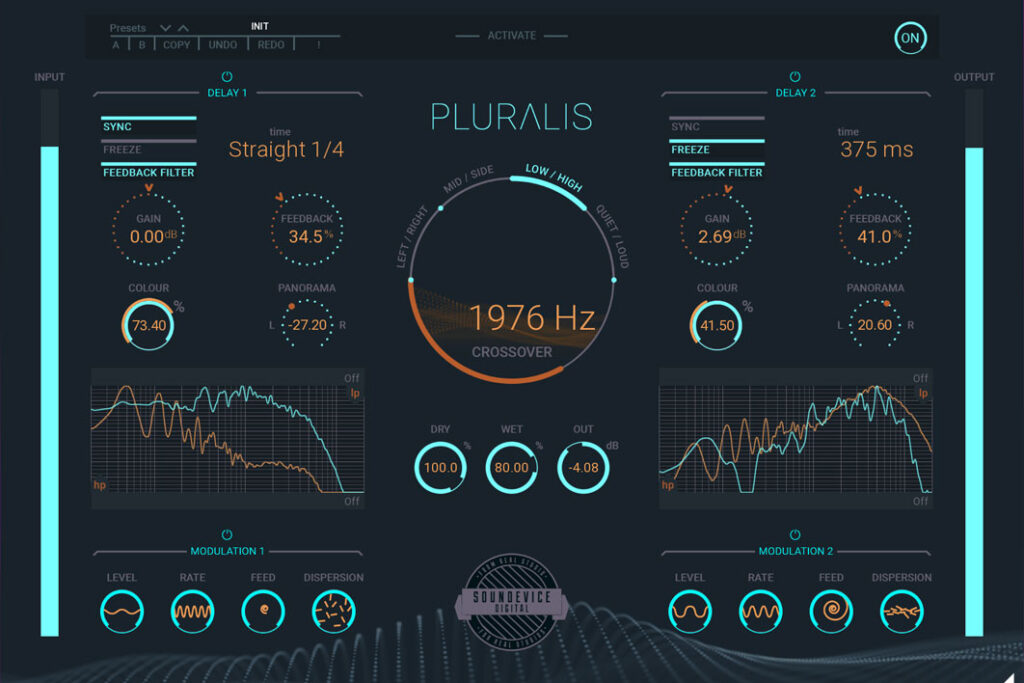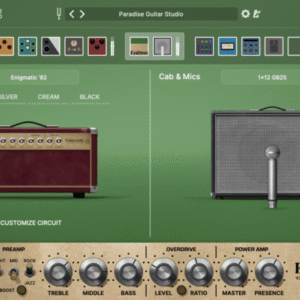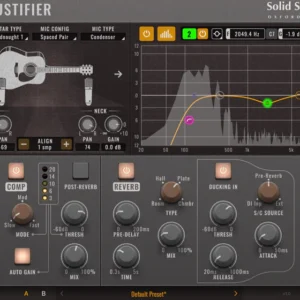
We only recommend products that we use and believe in. When you purchase through links on our site, we may earn an affiliate commission.
Uniquely layered delay design with several modes to split the signal makes Pluralis a delay like no other
Calling Pluralis a delay plug-in is an understatement; in a world full of analogue emulations — much as I love them, it was about time we had something fresh to work with.
Award-winning producer, sound designer, DJ, and multi-instrumentalist Zardonic (Artist Of The Year, 2016 Unión Rock Show Awards), 2023
Pluralistic power
Pluralis’ power lies in the way that it splits signals to then process them separately or in different combinations, thanks to four different modes: LEFT / RIGHT — splits the signal in a more traditional way, whereby users can apply DELAY 1 to the left channel and DELAY 2 to the right, representing a great way to get extreme effects at the outer edges of a mix or having gentle delays working within the side channels; MID / SIDE — splits the signal into the centre (mid) and left and right (side), so users can focus on different parts of their mix or stereo audio file to apply different processes to different audio areas as a different way of processing stereo audio files that is almost unheard of in delays (despite being commonly used in EQs and compressors); LOW / HIGH — harnesses powerful processing of different frequency ranges anchored around an adjustable frequency set by the CROSSOVER control to apply different delays to the low and high frequencies for totally flexible delay processing; and QUIET / LOUD — splits audio at a certain loudness level (also set by the CROSSOVER control) so that the two delay processors independently work on quieter and louder audio, a feature that is unique to the Pluralis plug-in, permitting users to utilise different delays on each element.
Two delays for the price of one
Signal-splitting abilities and layered delay design uniqueness notwithstanding, Pluralis plays with the concept of regular delay processing, presenting two delays — DELAY 1 and DELAY 2 — with standard controls for time, GAIN, and FEEDBACK, as well as ability to alter COLOUR (controls saturation of the delay and colour of the tape) and PANORAMA (controls the panorama of the delay — unavailable in LEFT / RIGHT and MID / SIDE modes), making it easy to achieve mix-ready, standard delays whenever the need arises, although SYNC (synchronisation to DAW tempo), FREEZE (freezes the delay sound, so the delay is endlessly repeated), and FEEDBACK FILTER (switches between the input filter — processes signal directly — and feedback filter — simulates tape echo behaviour — of the delay) functions are also available to encourage experimentation.
Modulation manoeuvres
Pluralis puts two modulation sections — MODULATION 1 and MODULATION 2 — into its users’ hands, helpfully allowing them to set self-explanatory values for LEVEL and RATE, as well as FEED (feedback) and DISPERSION (‘special effect’ that can shatter sound), so they can fine-tune how much modulation is set and applied to which parameters. Powerful and flexible, very dynamic delays can be created as a result.
Presets presented to inspire
Diving deep into unique-sounding delays need not be a daunting prospect; Pluralis presents several folders full of professionally-produced presets for each of its modes — including some notable ones created by award-winning producer, sound designer, DJ, and multi-instrumentalist Zardonic — to help out should inspiration fail to strike. Speaking of Zardonic (a.k.a. Federico Augusto Ágreda Álvarez), the Venezuela born-and-bred 2016 Unión Rock Show Awards winner famed for finding the perfect flashpoint between the heavy metal and electronic music worlds is clearly smitten, stating, “In a world full of analogue emulations — much as I love them, it was about time we had something fresh to work with; Cryostasis, Retronaut, Orbitron, and the new Pluralis became instant favourites for me!” It is little wonder, then, that he was happy to help out with producing Pluralis presets. Put it this way: as Zardonic concludes, “Calling Pluralis a delay plug-in is an understatement.” Ultimately, of course, he is right!
Key features:
- Splits signals to then process them separately or in different combinations, thanks to LEFT / RIGHT, MID / SIDE, LOW / HIGH, and QUIET / LOUD modes, some of which are unique to Pluralis
- Plays with the concept of regular delay processing — making it easy to achieve mix-ready, standard delays whenever the need arises — alongside encouraging experimentation
- Powerful and flexible modulation sections can create very dynamic delays
- Presents several folders full of professionally-produced presets for each of its modes
SounDevice Digital’s Pluralis is available to purchase for a time-limited introductory promo price of only €19.00 EUR until May 31, 2023 — rising thereafter to its regular price of €79.00 EUR — as an AAX-, AU-, VST-, and VST3-compatible plug-in (using internal 64-bit audio processing capable of handling any sample rate) directly from its dedicated webpage (https://unitedplugins.com/Pluralis/), where a 15-day, fully-functional trial version for macOS 10.10 and newer and Windows 8/10/11 can also be downloaded for free.
Note that no iLok, dongle, or internet access is required for Pluralis activation. (All United Plugins software uses license files for activation
and owners can freely use purchased software — with free-for-life updates — on all their computers, as long as they are the user.)
See and hear Pluralis in action while watching United Plugins’ illuminating introductory video here: https://youtu.be/W1_cfjXljMg



